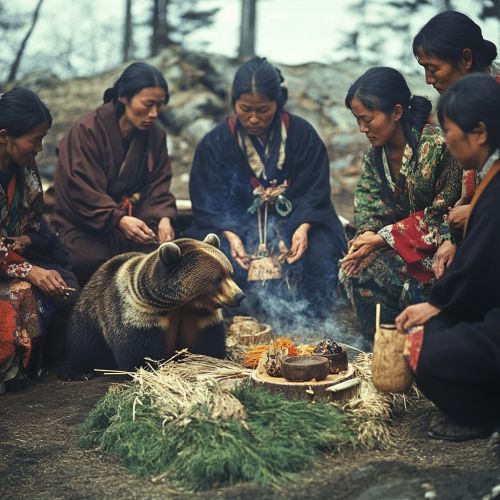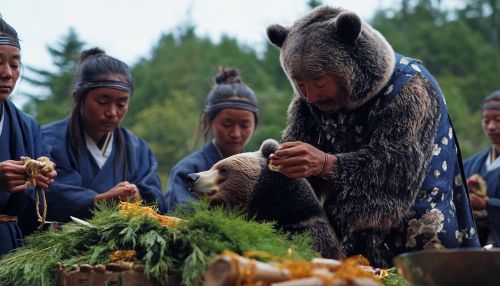Kamuy
Introduction
The term "Kamuy" refers to the deities or spiritual beings in the Ainu religion, indigenous to the Ainu people of Japan and Russia. These deities are believed to inhabit and govern various aspects of the natural world, including animals, plants, and natural phenomena. The concept of Kamuy is central to Ainu cosmology and spirituality, reflecting a deep connection with nature and the environment.
Etymology and Definition
The word "Kamuy" (カムイ) is derived from the Ainu language, where it signifies a divine or spiritual entity. The term is often translated as "god" or "spirit" in English, though it encompasses a broader range of meanings, including guardian spirits and ancestral deities. Unlike the monotheistic concept of a singular, omnipotent god, Kamuy are numerous and diverse, each with specific roles and attributes.
Cosmology and Beliefs
Ainu cosmology is animistic, meaning that it attributes spiritual essence to all elements of the natural world. The Kamuy are believed to inhabit various realms, including the heavens, earth, and underworld. They are responsible for the creation, maintenance, and destruction of the world, and their actions directly influence human life and natural events.
Types of Kamuy
Kamuy can be broadly categorized based on their domains and functions. Some of the most significant types include:
- **Nature Kamuy**: These deities govern natural elements such as rivers, mountains, and forests. For example, Kotan-kor-kamuy is the god of the village and protector of the community, while Kanna Kamuy is the god of thunder and lightning.
- **Animal Kamuy**: These spirits inhabit animals and are often revered as ancestors or protectors. Kim-un-kamuy, the bear god, is one of the most important animal Kamuy, symbolizing strength and protection.
- **Ancestral Kamuy**: These are spirits of deceased ancestors who continue to influence the living. They are often invoked in rituals and ceremonies to seek guidance and protection.
Rituals and Practices
Rituals dedicated to Kamuy are integral to Ainu religious practices. These rituals, known as "inau," involve offerings, prayers, and ceremonies to honor and appease the deities. Common offerings include food, sake, and carved wooden sticks called "inau."
Iomante Ceremony
One of the most significant rituals is the Iomante ceremony, a bear-sending ritual. In this ceremony, a captured bear, considered an incarnation of Kim-un-kamuy, is ritually killed and sent back to the spirit world with offerings and prayers. The ceremony is believed to ensure the bear's spirit will return to the human world with blessings and protection.


Prayer and Offerings
Daily prayers and offerings are common practices among the Ainu. These acts of devotion are performed to seek the favor of the Kamuy and ensure harmony between the human and spiritual worlds. Offerings often include rice, fish, and other natural products, reflecting the Ainu's deep connection to their environment.
Symbolism and Iconography
Kamuy are often represented through symbolic objects and iconography. Carved wooden figures, known as "nusa," are commonly used in rituals to symbolize the presence of Kamuy. These figures are placed in sacred spaces and are believed to act as intermediaries between the human and spiritual realms.
Tattoos and Clothing
Traditional Ainu tattoos and clothing also carry symbolic meanings related to Kamuy. Tattoos, particularly those on the hands and mouth, are believed to protect the wearer from evil spirits and ensure safe passage to the afterlife. Clothing, adorned with intricate patterns and designs, often depicts various Kamuy and their associated symbols.
Modern Interpretations and Revival
In recent years, there has been a resurgence of interest in Ainu culture and spirituality, including the worship of Kamuy. Efforts to revive traditional practices and educate younger generations about Ainu heritage have led to a renewed appreciation for these ancient beliefs.
Cultural Preservation
Organizations and cultural groups are actively working to preserve and promote Ainu traditions, including the rituals and stories associated with Kamuy. Museums, cultural centers, and educational programs play a crucial role in this revival, ensuring that the knowledge and practices of the Ainu people are passed down to future generations.
See Also
References
- Batchelor, John. "The Ainu and Their Folk-Lore." London: Religious Tract Society, 1901.
- Munro, Neil Gordon. "Ainu Creed and Cult." London: Routledge, 1995.
- Sugiura, Nobuo. "Ainu: Spirit of a Northern People." National Museum of Natural History, Smithsonian Institution, 1999.
